Philips HeartStart FR2 Service manual
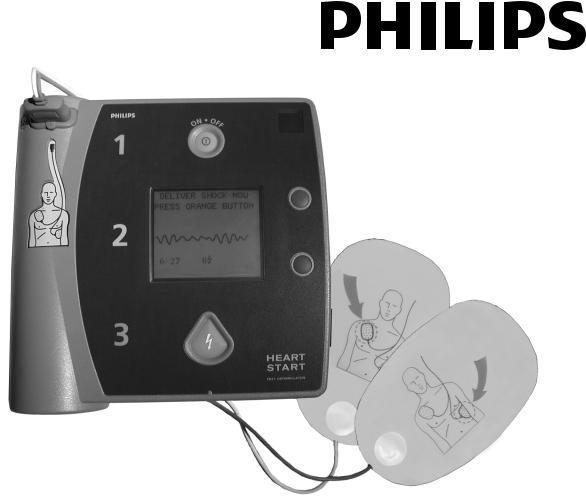
e É ~ ê í p í ~ ê í = c o O H = a É Ñ á Ä ê á ä ä ~ í ç ê
I N S T R U C T I O N S F O R U S E
M3860A, M3861A
Edition 15
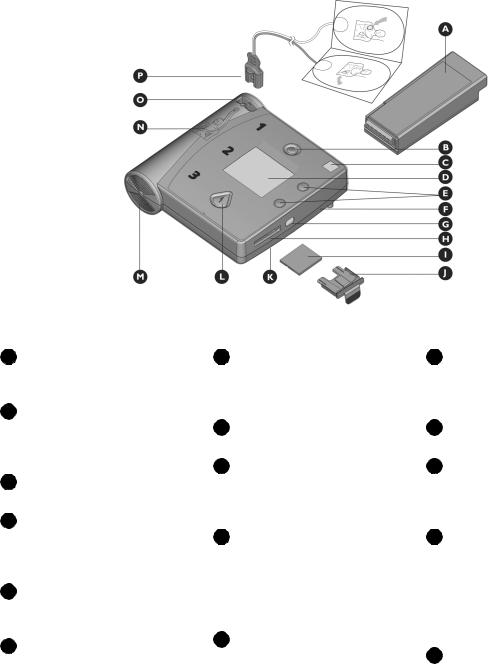
qЬЙ=eЙ~кнpн~кн=coOH=aЙСбДкбдд~нзк
A  Battery. Standard long-life or rechargeable battery used to power the FR2+.
Battery. Standard long-life or rechargeable battery used to power the FR2+.
B  On/Off button. Turns on the FR2+ and starts voice and text prompts. Second press turns off the FR2+.
On/Off button. Turns on the FR2+ and starts voice and text prompts. Second press turns off the FR2+.
C  Status Indicator. Shows you the readiness status of the FR2+.
Status Indicator. Shows you the readiness status of the FR2+.
D Display screen. Displays text prompts and incident data. The FR2+ M3860A screen also displays the patient’s ECG.
Display screen. Displays text prompts and incident data. The FR2+ M3860A screen also displays the patient’s ECG.
E  Option buttons. Adjust the contrast of the screen display and control special functions.
Option buttons. Adjust the contrast of the screen display and control special functions.
F  Beeper port. Broadcasts alert beeps when required. It is located under the right edge of the FR2+.
Beeper port. Broadcasts alert beeps when required. It is located under the right edge of the FR2+.
G  Infrared (IR) communications port. A special lens, or “eye,” used to transfer data directly to or from another device.
Infrared (IR) communications port. A special lens, or “eye,” used to transfer data directly to or from another device.
H Data card port. Receptacle for data card tray.
Data card port. Receptacle for data card tray.
I  Data card (optional). Used to store and review information about an incident, including ECG and optional voice recording.
Data card (optional). Used to store and review information about an incident, including ECG and optional voice recording.
J  Data card tray. Special sleeve that holds the data card and fits into the data card port to help seal the FR2+ against fluids. The tray should be kept installed in the FR2+ even if no data card is used.
Data card tray. Special sleeve that holds the data card and fits into the data card port to help seal the FR2+ against fluids. The tray should be kept installed in the FR2+ even if no data card is used.
K  Microphone. Used optionally to record surrounding audio during an incident. It is located under the right edge of the FR2+.
Microphone. Used optionally to record surrounding audio during an incident. It is located under the right edge of the FR2+.
L  Shock button. Controls shock delivery. The button flashes when the HeartStart FR2+ is ready to deliver a shock.
Shock button. Controls shock delivery. The button flashes when the HeartStart FR2+ is ready to deliver a shock.
M Speaker. Amplifies voice prompts during use of the FR2+.
Speaker. Amplifies voice prompts during use of the FR2+.
N Pads placement diagram.
Pads placement diagram.
Illustrates correct placement of adult pads. Diagrams are also shown on the defibrillator pads.
O Defibrillator pads connector socket. Receptacle for connector of the defibrillator pads cable. An adjacent LED light flashes to show socket location and is covered when connector is inserted.
Defibrillator pads connector socket. Receptacle for connector of the defibrillator pads cable. An adjacent LED light flashes to show socket location and is covered when connector is inserted.
P  Defibrillator pads. Selfadhesive pads with attached cable and connector. (Adult pads shown.)
Defibrillator pads. Selfadhesive pads with attached cable and connector. (Adult pads shown.)
SYSTEMS MEDICAL PHILIPS
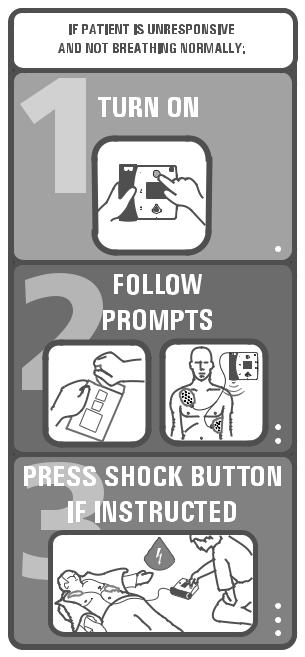
eЙ~кнpн~кн=coOH=aЙСбДкбдд~нзк
nrf`h=obcbobk`b=`^oa
PHILIPS MEDICAL SYSTEMS
Intentionally blank.
SYSTEMS MEDICAL PHILIPS

PHILIPS MEDICAL SYSTEMS
eÉ~êípí~êí=coOH
jPUSM^LjPUSN^
^мнзг~нЙЗ=bснЙке~д=aЙСбДкбдд~нзк
I N S T R U C T I O N S F O R U S E
Edition 15
IMPORTANT NOTE:
It is important to understand that survival rates for sudden cardiac arrest are directly related to how soon victims receive treatment. For every minute of delay, the chance of survival declines by 7% to 10%.
Defibrillation cannot assure survival. In some patients, the underlying problem causing the cardiac arrest is simply not survivable despite any available care.
About this edition
The information in this guide applies to the model M3860A/M3861A HeartStart FR2+ Defibrillator. This information is subject to change. Please contact Philips at www.medical.philips.com/heartstart or your local Philips representative for information on revisions.
Edition history
Edition 15
Publication date: April 2008
Publication number: 011120-0015
Printed in the U.S.A.
Copyright
© 2008 Philips Electronics North America
Corp.
No part of this publication may be reproduced, transmitted, transcribed, stored in a retrieval system or translated into any human or computer language in any form by any means without the consent of the copyright holder.
Unauthorized copying of this publication may not only infringe copyright but also reduce the ability of Philips Medical Systems to provide accurate and up-to-date information to users and operators alike.
Authorized EU Representative
Philips Medizin Systeme Boeblingen GmbH Hewlett-Packard Strasse 2
71034 Boeblingen, Germany
(+49) 7031 463-2254
CAUTION: Federal law (USA) restricts this device to sale by or on the order of a physician.
The HeartStart FR2+ is designed to be used only with Philips-approved accessories. The HeartStart FR2+ may perform improperly if non-approved accessories are used.
Device Tracking
This device is subject to tracking requirements by the manufacturer and distributors. If the defibrillator has been sold, donated, lost, stolen, exported, or destroyed, notify Philips Medical Systems or your distributor.
Device Manufacturer
The HeartStart FR2+ Defibrillator is manufactured by Philips Medical Systems, Seattle, Washington, USA.
Patents
This product is manufactured and sold under one or more of the following United States patents: U.S. Pat. No US6047212, US6317635, US5892046, US5891049, US6356785, US5650750, US6553257, US5902249, US6287328, US6662056, US5617853, US5951598, US6272385, US6234816, US6346014, US6230054,US6299574, US5607454, US5803927, US5735879, US5749905, US5601612, US6441582, US5889388, US5773961, US6016059, US6075369, US5904707, US5868792, US5899926, US5879374, US5632280, US5800460, US6185458, US5611815, US6556864, and other patents pending.
SYSTEMS MEDICAL PHILIPS
HEARTSTART FR2+ M3860A/M3861A

PHILIPS MEDICAL SYSTEMS
`lkqbkqp
N fkqolar`qflk=ql=qeb=eb^oqpq^oq=coOH |
|
Device description .......................................................................................... |
1-1 |
Indications for use ........................................................................................... |
1-1 |
Principles of operation ................................................................................... |
1-2 |
O dbqqfkd=pq^oqba |
|
Package contents ............................................................................................. |
2-1 |
Setup overview ................................................................................................. |
2-1 |
Installing the data card .................................................................................... |
2-1 |
Installing the battery and setting the clock ................................................ |
2-2 |
Running the Battery Insertion Test ............................................................. |
2-3 |
Placing and securing the HeartStart FR2+ ................................................. |
2-3 |
P rpfkd=qeb=eb^oqpq^oq=coOH |
|
Overview ........................................................................................................... |
3-1 |
Treating infants and children ........................................................................ |
3-1 |
Step 1: Preparation .......................................................................................... |
3-2 |
Step 2: ECG analysis and CPR interval ....................................................... |
3-3 |
Step 3: Shock delivery .................................................................................... |
3-4 |
CPR Interval .............................................................................................. |
3-4 |
ECG display for ongoing observation ......................................................... |
3-5 |
Q j^fkq^fkfkdI=qbpqfkdI=^ka=qolr_ibpellqfkd
Maintenance ...................................................................................................... |
4-1 |
Suggested maintenance schedule .......................................................... |
4-1 |
After using the HeartStart FR2+ .......................................................... |
4-2 |
Cleaning the HeartStart FR2+ .............................................................. |
4-3 |
Operator’s checklist ................................................................................ |
4-4 |
i
ii
|
Testing ............................................................................................................... |
4-5 |
|
Battery insertion selftest ........................................................................ |
4-5 |
|
Device history .......................................................................................... |
4-8 |
|
Battery History ......................................................................................... |
4-8 |
|
Troubleshooting Guide .................................................................................. |
4-9 |
|
Status indicator summary ....................................................................... |
4-9 |
|
Recommended action during an emergency ..................................... |
4-9 |
|
Troubleshooting during patient use .................................................... |
4-10 |
|
General troubleshooting ........................................................................ |
4-12 |
R |
p^cbqv=`lkpfabo^qflkp |
|
|
General dangers, warnings, and cautions ................................................... |
5-1 |
|
Defibrillation warnings and cautions ........................................................... |
5-3 |
|
Monitoring cautions ........................................................................................ |
5-4 |
|
Maintenance cautions ..................................................................................... |
5-4 |
S |
`lkcfdro^qflkI=pbqrmI=^ka=^as^k`ba=jlab=cb^qrobp |
|
|
Configuration ................................................................................................... |
6-1 |
|
Non-protocol parameters ..................................................................... |
6-1 |
|
Automatic protocol parameters .......................................................... |
6-2 |
|
Manual override parameters ................................................................. |
6-5 |
|
Using setup features ....................................................................................... |
6-6 |
|
Reviewing current setup ........................................................................ |
6-7 |
|
Revising setup ........................................................................................... |
6-7 |
|
Receiving setup ......................................................................................... |
6-8 |
|
Reading setup ............................................................................................ |
6-9 |
|
Sending and receiving clock settings .................................................... |
6-9 |
|
Using advanced mode features .................................................................... |
6-10 |
|
Using the manual analyze feature ......................................................... |
6-11 |
|
Using the manual charge feature (M3860A only) ............................. |
6-12 |
SYSTEMS MEDICAL PHILIPS
HEARTSTART FR2+ M3860A/M3861A
|
iii |
T a^q^=j^k^dbjbkq=^ka=obsfbt |
|
Overview ........................................................................................................... |
7-1 |
Recording incident data ................................................................................. |
7-1 |
Recording data in internal memory ..................................................... |
7-1 |
Recording data on a data card .............................................................. |
7-1 |
Reviewing Incident Data ................................................................................ |
7-2 |
Reviewing data from internal memory ................................................ |
7-2 |
Reviewing data from a data card .......................................................... |
7-3 |
PHILIPS MEDICAL SYSTEMS
iv
^mmbkaf`bp
^ ^ЕЕЙллзкбЙл=Сзк=нЬЙ=eЙ~кнpн~кн=coOH= _ qЙЕЬебЕ~д=pйЙЕбСбЕ~нбзел=
` dдзлл~ку=зС=лугДздл=~еЗ=Езенкздл=
adдзлл~ку=зС=нЙкгл=
b`mo=cбклн=`зеСбЦмк~нбзе=
c^ЗЗбнбзе~д=нЙЕЬебЕ~д=З~н~=кЙимбкЙЗ=Сзк=bмкзйЙ~е=ЕзеСзкгбну=
fåÇÉñ
SYSTEMS MEDICAL PHILIPS
HEARTSTART FR2+ M3860A/M3861A

PHILIPS MEDICAL SYSTEMS
1
N fенкзЗмЕнбзе=нз=нЬЙ=eЙ~кнpн~кн=coOH
Device description
The HeartStart FR2+ Defibrillator (“FR2+”) is a compact, lightweight, portable, and battery powered automated external defibrillator designed for use by a trained responder to treat ventricular fibrillation (VF), the most common cause of sudden cardiac arrest (SCA).
The FR2+ has a Status Indicator that is always active, so you can tell at a glance if it has passed its last selftest. The front panel of the FR2+ has an On/Off button at the top and a Shock button at the bottom. A display screen in the center of the panel provides text prompts and incident information. Voice prompts are provided through a speaker located at the base of the FR2+. See the diagram on the inside front cover for details.
The FR2+ is available in two models, the M3860A and the M3861A. They share a set of basic features, detailed in Chapter 6. The principle differences between the two models are identified below:
Model M3860A |
Model M3861A |
|
|
Configurable ECG display on screen |
Text prompt display on screen, no |
|
ECG display |
Configurable manual charge in |
No manual charge in advanced mode |
advanced mode (See Chapter 6) |
(See Chapter 6) |
|
|
NOTE:The FR2+ comes with a factory default setup that can be modified. (See Chapter 6, “Configuration, Setup, and Advanced Mode Features,” for a description of setup defaults and options.)
Indications for use
The HeartStart FR2+ is intended to be used with disposable defibrillator pads applied to victims of sudden cardiac arrest exhibiting the following symptoms:
•Unresponsiveness
•Absence of normal breathing
If in doubt, apply the pads.
1-1

1-2
To use the FR2+ on children under 8 years or 55 pounds (25 kg), apply FR2 Infant/ child reduced-energy defibrillator pads, if available. Otherwise, apply the standard pads.
WARNING: Performance of the SMART CPR AUTO1 and AUTO2 settings has not been established in patients under 8 years or 55 lb. (25 kg). See Appendix E for more information.
The FR2+ is intended for use by responders who have been trained in its operation. The user should be qualified by training in Basic Life Support (BLS), in Advanced Life Support (ALS), or another physician-authorized emergency medical response program.
At the discretion of emergency care personnel, the FR2+ M3860A can also be used with the FR2+ ECG assessment module to provide non-diagnostic display and evaluation of the heart rhythm of a responsive or breathing patient, regardless of age, for attended patient monitoring. While connected to the FR2+ ECG assessment module, the FR2+ M3860A disables its shock capability.
Principles of operation
The HeartStart FR2+ Defibrillator is designed to provide external defibrillation therapy to someone experiencing sudden cardiac arrest caused by ventricular fibrillation (VF), the most common cause of SCA. The only effective treatment for VF is defibrillation.The FR2+ treats VF by sending a shock across the heart, so it can start beating regularly again.
The FR2+ is extremely easy to use. When connected to defibrillator pads that are properly applied to the patient’s bare chest, the FR2+:
1.prompts you to take specific actions,
2.automatically analyzes the patient's heart rhythm and advises you whether or not the rhythm is shockable, and
3.arms the Shock button, if appropriate, and instructs you to press it to deliver a biphasic electric pulse designed to defibrillate the heart.
Detailed instructions for use are provided in Chapter 3.
SYSTEMS MEDICAL PHILIPS
HEARTSTART FR2+ M3860A/M3861A
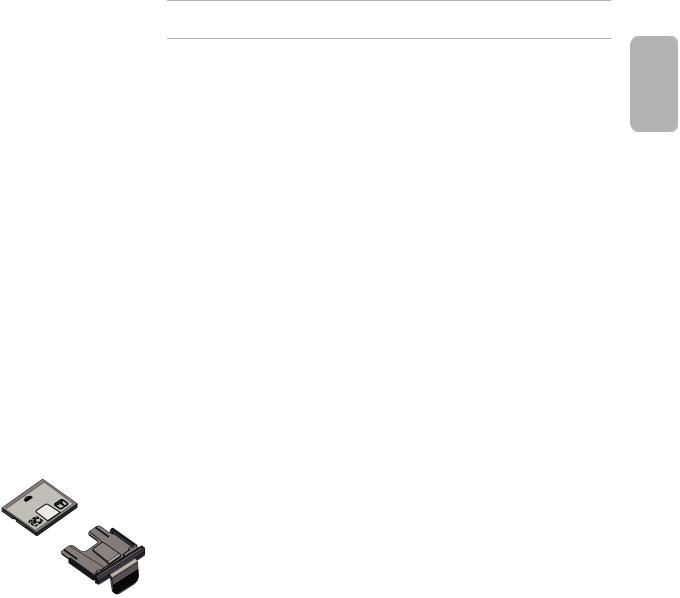
PHILIPS MEDICAL SYSTEMS
O dЙннбеЦ=pн~кнЙЗ
Package contents |
2 |
The HeartStart FR2+ Defibrillator is supplied with a standard long-life battery, two sets of adult defibrillator pads with integrated cable and connector, and a data card tray. Other accessories, including FR2 infant/child reduced-energy defibrillator pads, an FR2+ rechargeable battery, and (for M3860A only, with ECG display enabled) a three-wire FR2+ ECG assessment module, are available. See Appendix A for a list of accessories and other recommended supplies.
Setup overview
Setting up the HeartStart FR2+ for use is quick and simple.
•Install a data card. (optional)
•Install a battery.
•Set the clock in the FR2+. (optional)
•Run the battery insertion selftest.
•Place the FR2+ with recommended accessories in a convenient location.
Installing the data card
The HeartStart FR2+ comes with a data card tray, which should be kept in the data card port even if no data card is used. If a data card is to be used, install it as follows:
1.Load the data card face up into the data card tray, with the tray’s “tongue” fitting over the matching yellow area on the data card.
2.Press the On/Off button to turn off the HeartStart FR2+ if it is on.
3.Hold the loaded data card tray by its handle and gently insert the tray all the way into the defibrillator’s data card port until only the tab remains outside the case.
2-1

2-2
The data card will automatically record incident data the next time the HeartStart
FR2+ is turned on.
Installing the battery and setting the clock
The HeartStart FR2+ Defibrillator is shipped with an M3863A standard, long-life battery. The battery is enclosed in a gray plastic case with a yellow latch at one end, designed to hold the battery in place when it is correctly installed. (The optional M3848A FR2+ rechargeable battery case is blue, and it also has a yellow latch. Except where otherwise noted, the following information applies to both battery types.) To install the battery:
1. Hold the battery by the latch end and slide it into the battery compartment at the top of the HeartStart FR2+.
2. Slide the battery all the way into the opening, until the latch clicks into place.
CAUTION:Follow all instructions supplied with the battery. Install the battery before the install-by date shown on the battery.
When the battery is installed, the FR2+ automatically turns on. The Status Indicator displays a flashing black hourglass. The Shock button light and the indicator light for the defibrillator pads connector socket turn on briefly. The display screen brings up the main menu.
It is recommended that you set the FR2+’s internal clock to the correct date and local time at this point.

 1. Within 10 seconds of installing the battery, press the lower Option button to move the highlight bar on the displayed main menu to NEXT.
1. Within 10 seconds of installing the battery, press the lower Option button to move the highlight bar on the displayed main menu to NEXT.
2. Press the upper Option button to select NEXT to bring up the second menu screen.
3. Press the lower Option button to move the highlight bar to CLOCK.
4. Press the upper Option button to bring up the CLOCK menu.
5. To receive clock settings from another FR2+, see directions provided in Chapter 6. To manually set the time and date, follow the remaining steps.
SYSTEMS MEDICAL PHILIPS
HEARTSTARTFR2+ M3860A/M3861A

PHILIPS MEDICAL SYSTEMS
2-3
6.Press the lower Option button to move the highlight bar to the date or time
field to be changed.
7.Using the upper Option button, scroll through the available settings to the
|
|
|
|
desired value. |
2 |
8. |
Use the lower Option button to move to any other date or time field to be |
|
|||
|
|
|
|
changed, and repeat step 6. |
|
9. |
When all selections have been made, use the lower Option button to move |
|
|||
|
|
|
|
the highlight bar to RETURN, then press the upper Option button to return to |
|
|
|
|
|
the second menu. |
|
|
|
|
|
|
|
|
|
|
|
|
|
|
|
|
|
|
|
10. After ten seconds, the HeartStart FR2+ automatically starts the battery insertion selftest.*
If you choose not to set the clock at this point, the HeartStart FR2+ automatically starts the battery insertion selftest within ten seconds of battery insertion. You can remove and reinsert the battery at any time to review or adjust the clock settings.
Running the Battery Insertion Test
The battery insertion selftest has two parts, an automatic part, during which the screen displays a bar that fills in as the test continues, followed by an interactive part. Follow the defibrillator’s prompts during the interactive part of the test.
When the FR2+ has passed the battery insertion selftest, it turns off and goes to standby mode to be ready for use. Standby mode is indicated by the flashing black hourglass status indicator.
NOTE:If the battery is removed from the FR2+ for more than two hours, the clock settings will be lost and must be reset.
Placing and securing the HeartStart FR2+
Place the HeartStart FR2+ Defibrillator in an accessible area with the Status Indicator easily visible. The defibrillator can be secured in a carrying case suitable for use with a wallmount bracket or defibrillator cabinet. Useful accessories for
* See Chapter 4 for details about the battery insertion selftest.

2-4
storage with the HeartStart FR2+ include a spare battery, spare pads, spare data card (if used), and a Fast Response Kit containing a pocket mask, a disposable razor, 2 pairs of gloves, a pair of paramedics scissors, and an absorbent wipe. See Appendix A for a list of accessories.
NOTE:Be careful not to overpack the carrying case, to avoid placing inadvertent pressure on the control buttons. Do not store the FR2+ with the defibrillator pads attached. Do not open the pads package until ready for use.
With the battery installed and the FR2+ stored in appropriate environmental conditions,* the FR2+ performs detailed daily, weekly, and monthly selftests to check its readiness for use. These periodic selftests are described in Chapter 4.
While the FR2+ is in the standby mode, the Status Indicator shows the flashing black hourglass unless the periodic selftest detects a problem. If a problem is detected, the Status Indicator will show a flashing red X or a solid red X and the FR2+ will chirp to alert you. Chapter 4 contains instructions for troubleshooting.
* See Appendix B for environmental specifications.
SYSTEMS MEDICAL PHILIPS
HEARTSTARTFR2+ M3860A/M3861A

PHILIPS MEDICAL SYSTEMS
P rëáåÖ=íÜÉ=eÉ~êípí~êí=coOH
Overview
This chapter describes how to use the HeartStart FR2+ Defibrillator in an emergency. Some general things to remember are:
Try to relax and stay calm. The HeartStart FR2+ automatically provides voice
and text prompts to guide you through each step of its use. |
3 |
|
The defibrillator pads must have good contact with the patient’s skin. The pads have a layer of sticky, conductive gel beneath the protective backing.
It may be necessary to dry the patient’s skin or to clip or shave excessive chest hair to provide good contact between the defibrillator pads and the patient’s skin.
Be sure to read the Warnings and Cautions on the last page of this chapter.
Detailed directions for use based on default configuration are provided on the following pages.
NOTE:These directions apply to both the model M3860A and the model
M3861A FR2+, except where otherwise noted.
Treating infants and children
WARNING: Most cardiac arrests in children are not caused by heart problems. When responding to cardiac arrest in an infant or child:
•Provide infant/child CPR while a bystander calls EMS and brings the FR2+.
•If no bystander is available, provide 1-2 minutes of CPR before calling EMS and retrieving the FR2+.
•If you witnessed the child's collapse, call EMS immediately and then get the FR2+.
Alternatively, follow your local protocol.
3-1
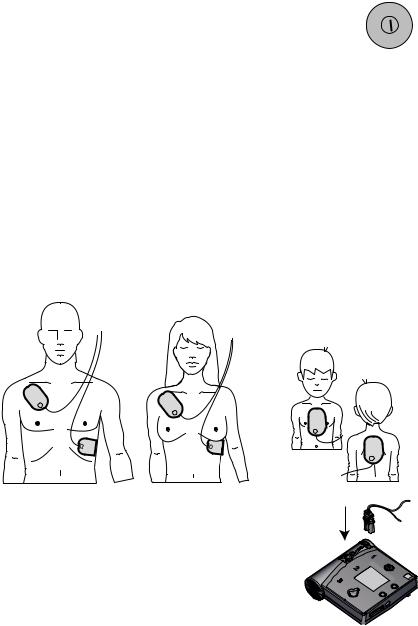
3-2
Step 1: Preparation
Press the On/Off button to turn on the HeartStart FR2+ |
N |
• |
O |
|
|
|
F |
||
|
|
|
||
Defibrillator. Follow the instructions provided by the FR2+ voice |
O |
|
|
F |
|
|
|
||
and text prompts.
•Remove clothing from the patient's upper body. If needed, wipe moisture from the patient's skin and clip or shave excessive chest hair.
•If the patient appears to be under eight years of age or 55 lb. (25 Kg), use M3870A FR2 infant/child reduced-energy defibrillator pads, if available. If the infant/child pads are not available, or if the child appears older/larger, use adult defibrillator pads. DO NOT DELAY TREATMENT TO DETERMINE THE CHILD’S EXACT AGE/WEIGHT.
•Open the defibrillator pads package. Pull off the protective backing from the
defibrillator pads.
•Place the sticky side of each pad on the patient’s bare skin, exactly as shown on the drawing on each pad.
Pad placement for adults and children 8 years old or 55 pounds or more.
Pad placement for infants and children under 8 years old or 55 pounds.
•Insert the defibrillator pads connector firmly into the defibrillator’s connector socket, indicated by a flashing light at the top left of the FR2+.
SYSTEMS MEDICAL PHILIPS
HEARTSTART FR2+ M3860A/M3861A
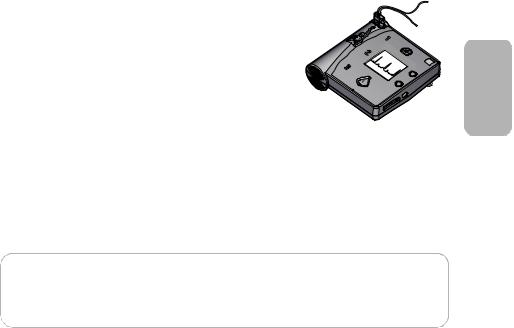
PHILIPS MEDICAL SYSTEMS
3-3
Step 2: ECG analysis and CPR interval
Follow the instructions provided by the FR2+ Defibrillator’s voice and text prompts.
As soon as the FR2+ detects that the defibrillator pads are connected properly, it automatically begins analyzing the patient’s heart rhythm. Do not touch the patient during rhythm analysis.
If no shock is advised, the HeartStart FR2+ provides |
3 |
|
|
voice and text prompts to tell you so and provides a |
|
CPR interval with a prompt to perform CPR, if |
|
needed. The duration of the CPR interval is determined by CPR Timer setting. |
|
Following the CPR interval, the FR2+ reanalyzes the patient’s heart rhythm. If no shock is again advised, the device goes into a patient care interval, during which you can perform CPR if needed or otherwise tend to the patient. The duration of the patient care interval is determined by the NSA Action setting.
NOTE:CPR may interfere with background heart rhythm monitoring by the FR2+ in monitoring mode. During CPR, periodically pause for 15 seconds to reassess the patient and allow the FR2+ to analyze the patient’s heart rhythm without possible interference from CPR artifact.
If a shock is advised, the HeartStart FR2+ charges to prepare for shock delivery. It gives the voice and text prompts to tell you that a shock is advised.
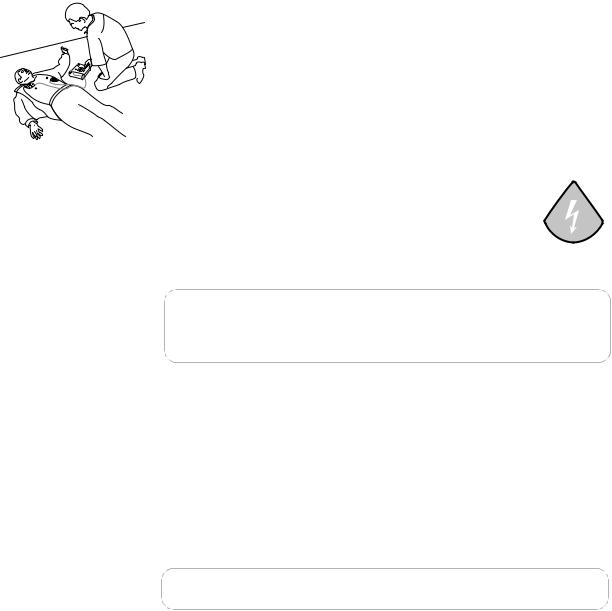
3-4
Step 3: Shock delivery
First, make sure that no one is touching the patient or the pads. While the FR2+ is charging, it continues to analyze the patient’s heart rhythm. If the rhythm changes and a shock is no longer appropriate, the FR2+ disarms. Voice and text prompts advise you what action to take.
There are four ways you can tell that the defibrillator is ready to deliver a shock:
• you hear a voice prompt telling you to deliver a shock,
• you see the Shock button flashing,
• you hear a steady tone, and/or
• you see a text prompt telling you to press the orange (Shock) button.
Press the Shock button to deliver the shock.
IMPORTANT: You must press the button for a shock to be delivered. The HeartStart FR2+ Defibrillator will not automatically deliver a shock. This safety feature allows you to verify that the patient is clear before a shock is delivered.
NOTE:If you do not press the Shock button within 30 seconds of being prompted, the HeartStart FR2+ will disarm itself and provide a pause. It will resume analyzing heart rhythm after 30 seconds or when the Resume Analyzing key is pressed.
After you press the Shock button, a voice prompt tells you the shock was delivered. Then the FR2+ pauses to allow you to perform CPR. The duration of this CPR interval is determined by the CPR Timer setting.
CPR Interval
After telling you that it has paused, the FR2+ gives no more voice prompts during the CPR interval, so that you can provide uninterrupted patient care. During the CPR interval, the FR2+ screen shows a bar that fills in as the CPR interval is used up. The HeartStart FR2+ M3860A also displays the ECG, if enabled, during this period.
NOTE:It is important to perform CPR for the entire duration of the CPR interval, until you hear the voice prompt telling you to stop CPR.
SYSTEMS MEDICAL PHILIPS
HEARTSTART FR2+ M3860A/M3861A

PHILIPS MEDICAL SYSTEMS
3-5
ECG display for ongoing observation
At the discretion of emergency care personnel, the HeartStart FR2+ M3860A with |
|
ECG display enabled can also be used with the M3873A/M3874A FR2+ ECG |
|
assessment module to provide a non-diagnostic ECG display of the patient’s heart |
|
rhythm for attended patient monitoring. The system is intended for use on a |
|
conscious or breathing patient, regardless of age. While connected to the FR2+ |
|
ECG assessment module, the FR2+'s shock capability is disabled, but the FR2+ |
|
continues to evaluate the patient's ECG. There are no known contraindications to |
|
use of the FR2+ ECG assessment module. |
3 |
The module is designed for connection to ECG electrodes per AAMI (M3873A) or IEC (M3874A) color convention. The module’s colored leadwires are connected to ECG electrodes, which are then placed on the patient’s bare chest, and the module’s device connector is inserted in the FR2+’s connector socket.
NOTE:It is not necessary to turn the FR2+ Defibrillator off prior to connecting the ECG assessment module.
Once connected, the HeartStart FR2+ displays and evaluates the patient's ECG (Lead II). Follow all prompts from the defibrillator. If a data card is used when the ECG assessment module is connected, all recorded events can be viewed using one of the Event Review data management software products.
Check the patient if:
•indicated by the observed ECG display,
•the patient becomes unresponsive or stops breathing, or
•the FR2+ prompts IF NEEDED, ATTACH DEFIBRILLATION PADS.
If appropriate, unplug the ECG assessment module from the FR2+, attach the defibrillator pads to the patient, and connect the defibrillator pads to the FR2+. Verify that the defibrillator pads are at least one (1) inch (2.5 cm) away from the ECG electrodes.

3-6
WARNING:During defibrillation, air pockets between the skin and defibrillator pads can cause patient skin burns. To help prevent air pockets, make sure defibrillator pads completely adhere to the skin.
WARNING:Do not let the defibrillator pads touch each other or other ECG electrodes, lead wires, dressings, transdermal patches, etc. Such contact can cause electrical arcing and patient skin burns during defibrillation and may divert defibrillating current away from the heart.
WARNING:Handling or transporting the patient during heart rhythm analysis can cause an incorrect or delayed diagnosis. If the FR2+ gives a SHOCK ADVISED prompt, keep the patient as still as possible for at least 15 seconds so the HeartStart FR2+ can reconfirm the rhythm analysis before a shock is delivered.
WARNING:CPR rates significantly above 100 compressions per minute can cause incorrect or delayed analysis by the FR2+. Under certain circumstances, this may result in a prompt to stop all movement so that the device can confirm rhythm analysis.
WARNING:Defibrillation current can cause operator or bystander injury. Do not touch the patient during defibrillation. Do not allow the defibrillator pads to touch any metal surfaces. Disconnect the pads connector from the FR2+ before using any other defibrillator.
CAUTION: Aggressive handling of the pads in storage or prior to use can damage the pads. Discard the defibrillator pads if they become damaged.
CAUTION: Do not place the pads directly over an implanted pacemaker or defibrillator. A noticeable lump with a surgical scar should indicate its position.
SYSTEMS MEDICAL PHILIPS
HEARTSTART FR2+ M3860A/M3861A

PHILIPS MEDICAL SYSTEMS
Q j~бен~бебеЦI=qЙлнбеЦI=~еЗ=qкзмДдЙлЬззнбеЦ
Maintenance |
|
Maintenance of the FR2+ is very simple, but it is a very important factor in its |
|
dependability. When in standby mode (with the battery installed), the FR2+ |
|
performs many maintenance activities itself. These include daily and weekly |
|
selftests to verify readiness for use and more detailed monthly selftests that also |
|
verify the shock waveform delivery system. In addition, each time the FR2+ is first |
|
turned on, it executes a selftest. Further, a detailed battery insertion selftest is run |
|
whenever a battery is installed in the FR2+. |
|
The FR2+ requires no calibration or verification of energy delivery. The FR2+ has |
|
no user-serviceable parts. |
4 |
|
|
CAUTION: Improper maintenance may damage the FR2+ or cause it to |
|
function improperly. Maintain the FR2+ only as described in these Instructions |
|
for Use or as designated by your program's Medical Director. |
|
CAUTION: Electrical shock hazard. Dangerous high voltages and currents are |
|
present. Do not open the FR2+, remove its covers, or attempt repair. There |
|
are no user-serviceable components in the FR2+. The FR2+ should be returned |
|
to Philips for repair. |
|
Suggested maintenance schedule |
|
The following table presents a sample maintenance schedule for the FR2+. |
|
Different frequency intervals may be appropriate, depending upon the |
|
environment in which the FR2+ is used. The required maintenance frequency is at |
|
the discretion of your program’s Medical Director. |
|
4-1
4-2
daily |
monthly |
maintenance task/response |
|
|
|
|
|
Check the Status Indicator. |
|
|
If you see the flashing black hourglass: The FR2+ is ready to use. |
|
|
No action required. |
|
|
If you see anything other than a flashing black hourglass, remove |
|
|
and reinstall the battery to run the selftest. |
|
|
• If the selftest passes and the Status Indicator shows the |
|
|
flashing black hourglass, the FR2+ is ready to use. |
|
|
• If the selftest fails, install a new battery and run the selftest. If |
|
|
the selftest passes, the FR2+ is ready to use. If the selftest |
|
|
fails, contact Philips Medical Systems. |
|
|
• If the selftest does not run, check to be sure that there is no |
|
|
pads connector installed in the FR2+. |
|
|
Check supplies, accessories, and spares for damage and |
|
|
expiration dating. |
|
|
Do not use damaged or expired accessories. Replace them |
|
|
immediately. |
|
|
If a LOW BATTERY or REPLACE BATTERY message is |
|
|
displayed: Replace the battery and run the selftest. |
|
|
• Do not attempt to charge the M3863A FR2 standard battery. |
|
|
It is not rechargeable. |
|
|
• The M3848A FR2+ battery is rechargeable. Recharge it, using |
|
|
the M3849A Charger only. |
|
|
Check the outside of the FR2+ and the connector socket |
|
|
for cracks or other signs of damage. |
|
|
If you see signs of damage: Contact Philips for technical support. |
|
|
|
After using the HeartStart FR2+
After each use of the FR2+, in addition to the maintenance tasks described in the table above, perform the following post-use checks before returning the FR2+ to service:
•Check the operation of the FR2+ by removing and reinstalling the battery and running the battery insertion selftest.
•Check the outside of the FR2+ and the connector socket for signs of dirt or contamination. If the FR2+ is dirty or contaminated, clean it according to the guidelines provided in this manual.
SYSTEMS MEDICAL PHILIPS
HEARTSTART FR2+ M3860A/M3861A

PHILIPS MEDICAL SYSTEMS
4-3
•Check the data card if one has been used. If the data card has been used to record incident data, remove and replace it with a blank data card. Deliver the recorded data card to appropriate personnel according to your local guidelines and medical protocol.
•Check the connector socket to make sure that defibrillator pads are disconnected from the FR2+ when it is not in use.
•Check to make sure the data card tray is installed, even if a data card is not being used.
Cleaning the HeartStart FR2+
The outside of the FR2+, including the defibrillator pads connector socket, can be cleaned with a soft cloth dampened in one of several appropriate cleaning agents (see list below). The following guidelines include some important reminders:
• Do not immerse the FR2+ in fluids. |
4 |
|
•Make sure a battery (or the M3864A Training & Administration Pack) and a data card tray are installed when cleaning the FR2+, to keep fluids out of the device.
•Do not use abrasive materials, cleaners, strong solvents such as acetone or acetone-based cleaners, or enzymatic cleaners.
•Clean the FR2+ and the connector socket with a soft cloth dampened with one of the cleaning agents listed below.
—Isopropyl alcohol (70% solution)
—Soapy water
—Chlorine bleach (30 ml/l water)
—Ammonia-based cleaners
—Glutaraldehyde-based cleaners
—Hydrogen peroxide
CAUTION:Do not immerse any portion of the FR2+ in water or other fluids. Do not allow fluids to enter the FR2+. Avoid spilling any fluids on the FR2+ or accessories. Spilling fluids into the FR2+ may damage it or present a fire or shock hazard. Do not sterilize the FR2+ or accessories.

4-4
Operator’s checklist
The following checklist is for your reference. You may want to photocopy it or use it as the basis for creating your own checklist.
lmbo^qloDp=`eb`hifpq
HeartStart FR2+ Model No.: ________________________ Serial No.: _________________________________
HeartStart FR2+ Location or Vehicle ID: _________________________________________________________
Date
Scheduled frequency
HeartStart FR2+
Clean, no dirt or contamination; no signs of damage
Supplies available
•Two sets defibrillator pads, sealed, undamaged, within expiration date
•Ancillary supplies (hand towel, scissors, razor, pocket mask, gloves)
•Spare M3863A battery, within “Install Before” date
•Data cards, undamaged, and spare data card tray
Status indicator
Shows alternating hourglass/square; selftest passed.
Inspected by
Signature or initials of operator completing the maintenance inspection
Remarks, problems, corrective actions
SYSTEMS MEDICAL PHILIPS
HEARTSTART FR2+ M3860A/M3861A
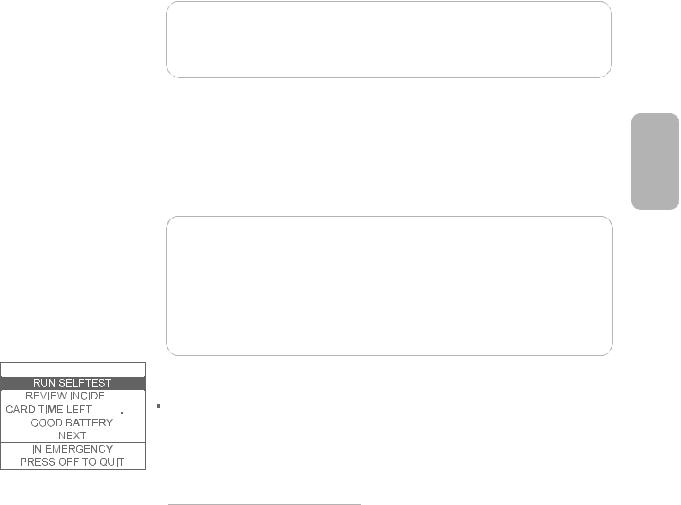
PHILIPS MEDICAL SYSTEMS
4-5
Testing
The HeartStart FR2+ Defibrillator has several ways of testing itself and alerting you if it finds a problem. In addition to the selftest performed each time it is turned on and each time a battery is installed, the FR2+ also automatically performs periodic selftests daily.
NOTE:The FR2+ selftests are designed to check that the FR2+ is ready for use. However, in the event that the FR2+ has been dropped or mishandled, it is recommended that the battery be removed and reinstalled to initiate a selftest. If the FR2+ has visible signs of damage, contact Philips for technical support.
Battery insertion selftest
Before running the battery insertion selftest, be sure that neither the defibrillator |
|
pads nor the FR2+ ECG assessment module are connected to the device. When |
|
you insert the battery, the main menu is displayed and a two-part selftest will run |
4 |
unless you make another selection from the menu* within 10 seconds. The selftest |
|
includes an automatic part and an interactive part.
NOTE:The menu screen will not appear when a battery is inserted if:
•the defibrillator pads are attached to a patient, indicating that the FR2+ is in use,
•the FR2+ ECG assessment module is connected to the FR2+, or
•the battery is completely depleted.
If less than five minutes have passed since the FR2+ was last used, the menu screen will be displayed, but after 10 seconds the FR2+ will go to standby mode if you make no selection.
To run the battery insertion selftest, remove and reinstall the battery. The screen  tells you whether or not a data card is installed. If it is, a screen message displays
tells you whether or not a data card is installed. If it is, a screen message displays 

 how much recording time is left until the data card is full.
how much recording time is left until the data card is full.
*To move around the menus displayed, use the Option buttons as follows:
•Press the lower Option button to move the highlight bar from one item to another on the menu.
•Press the upper Option button to select the highlighted item or to scroll through the settings for that item.
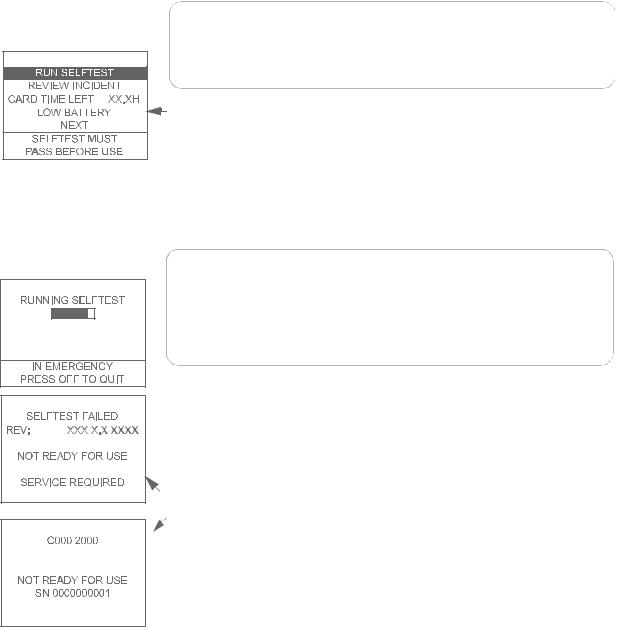
4-6
NOTE:The data card is typically capable of storing a number of incidents. However, it is recommended that it be cleared or replaced after every use. In the unlikely event that the card fills up during an incident, no further data can be recorded, so it is important for you to monitor the CARD TIME LEFT information on this screen.
Text prompts tell you if the battery power is low. If so, replace the battery. If a previous selftest has failed, the screen displays a message that the FR2+ must pass a selftest before being used.
It is a best practice to always have a spare battery available. However, if you do not have a spare battery when a screen display prompts you to replace the battery or the Status Indicator shows a flashing red X, you can continue to use the FR2+ until the battery is completely depleted. This may be necessary in an emergency.
NOTE:The M3848A FR2+ rechargeable battery should not be used as a spare or backup battery.
NOTE:If you connect defibrillator pads (that are applied to the patient) or the FR2+ ECG assessment module to the FR2+ during a battery insertion selftest, the selftest will stop and the FR2+ will go to its standby mode to be ready for use.
 During the automatic part of the selftest, the screen displays a bar that fills in as the test continues. When that part of the test is finished, the FR2+ beeps. If a data card was inserted in the FR2+ prior to installing the battery, the results of the selftest are automatically recorded on the data card.
During the automatic part of the selftest, the screen displays a bar that fills in as the test continues. When that part of the test is finished, the FR2+ beeps. If a data card was inserted in the FR2+ prior to installing the battery, the results of the selftest are automatically recorded on the data card.
If the automatic part of the selftest detects a problem:
• The screen displays a message that the selftest has failed. After a short time, an error code is displayed. Write down the error code and serial number.
 • The Status Indicator shows a flashing or solid red X.
• The Status Indicator shows a flashing or solid red X.
Replace the battery with a new battery and repeat the test. If the second selftest fails, contact Philips for technical support.
SYSTEMS MEDICAL PHILIPS
HEARTSTART FR2+ M3860A/M3861A

4-7
If the automatic part of the selftest passes:
• The screen displays a message that the selftest passed, then begins the interactive part of the test.
The interactive part of the selftest requires you to respond to prompts in order to make sure the display, buttons, lights, and speaker on the FR2+ are working properly.
Text prompts guide you through a series of steps in the interactive part of the selftest. Some ask you to observe that a feature of the FR2+ works properly. Others ask you to take certain actions — for example, to press a button. The screen then displays a message showing that the button’s operation has been verified. If you do not press the button, or if you do but the button is not working, the screen displays a message that the button’s function is not verified.
4
PHILIPS MEDICAL SYSTEMS
If something does not work correctly — for example, if lights do not come on or you do not hear beeps when expected — make a note of the problem and contact Philips for technical support.
NOTE:Do not use the FR2+ if any parts of the interactive selftest indicate a problem. Be sure to note and report any problems you find.
When the interactive part of the battery insertion selftest is complete, the FR2+ turns off and goes to standby mode to be ready for use.
If it detects a problem during any selftest, the FR2+ beeps and displays a flashing red X or a solid red X on the Status Indicator.

4-8
Device history
The FR2+ stores key information about its history in internal memory. To review the history of your FR2+, select NEXT from the main menu screen displayed when  you insert the battery, then select DEVICE HISTORY from the next menu displayed.
you insert the battery, then select DEVICE HISTORY from the next menu displayed.
The device history information includes:
 • USES — how many times the FR2+ has been used (shown in the left column of numbers) and the total time in minutes it has been used (shown in the right column of numbers);
• USES — how many times the FR2+ has been used (shown in the left column of numbers) and the total time in minutes it has been used (shown in the right column of numbers);
• SHOCKS — the total number of shocks it has delivered;
• TRAINING — how many times it has been used with the Training & Administration Pack for training (left column) and the total time in minutes it has been used for training (right column); and
•TESTS — how many tests have been run. Four figures are shown: daily (upper
left), weekly (upper right), and monthly (lower left) periodic selftests, and battery insertion selftests (lower right).
• REV — device model, software version and language.
 Battery History
Battery History
Information about use of the battery currently installed in your FR2+ is also available. To review the history of the battery, select NEXT from the menu screen displayed when you insert the battery, then select BATTERY HISTORY from the next menu displayed.


 The battery history information is read from the internal memory of the battery. It
The battery history information is read from the internal memory of the battery. It  includes:
includes:
• USE MINUTES — the total operating time (in minutes), including selftest time, for this battery;
• CHARGES — the total number of full defibrillation charges that have been provided by this battery, including selftest charges;
 • BATTERY READINESS — a GOOD BATTERY message (M3863A) or a fuel gauge
• BATTERY READINESS — a GOOD BATTERY message (M3863A) or a fuel gauge
display (M3848A) showing 25%, 50%, 75% or 100%, or a LOW BATTERY or message, as appropriate.
SYSTEMS MEDICAL PHILIPS
HEARTSTART FR2+ M3860A/M3861A
